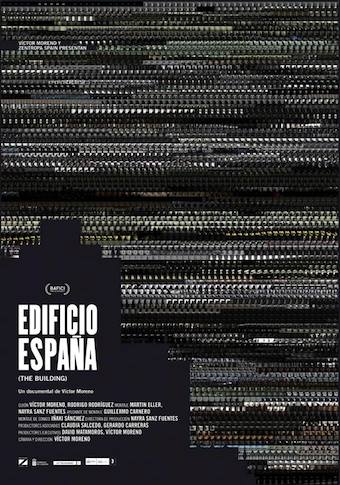
This piece was originally posted on the old blog in October 2014 (how the film came to my attention is explained within the piece) – I have only edited it for clarity (some of my sentences are too long in the original version) and so that any dates referred to make sense. All of the images included below are from the film’s Facebook page, rather than my normal habit of creating screenshots (the DVD hadn’t been released at this point – when I contacted him to ask about possible ways of seeing the film, Víctor Moreno kindly gave me access to an online screener). The film pays attention to two themes that I find myself drawn to: processes of work; and marked absences in architectural spaces.
‘[I]f the myth states that Madrid has the highest “national” significance, then a critique of the “nation” as the myth conceives it becomes possible through a critical reading of Madrid.’ (Resina 2001: 69)
Inaugurated in 1953 (works began in 1947), Edificio España is a colossus occupying an entire block in the heart of Madrid, where the Gran Vía meets Plaza de España. Designed by architect Julián Otamendi (also responsible for the neighbouring Torre de Madrid, which took over the title of the capital’s tallest building in 1957), Edificio España – as its name suggests – was part of Franco’s project to change Spain’s image in the world, to build a symbol of prosperity to dispel the lingering image of an impoverished and extended postwar period. Deliberately American in style, this immense structure effectively contained a small city within it. The opening credits of Víctor Moreno’s documentary outline its vast capacity: 28 floors, 200 dwellings, 400 offices, shopping arcades, various restaurants, and a luxury hotel. At its peak, 3,500 people passed through its main foyer on a daily basis.
Although it remains imposing, its grandeur and status as the centre of city life started to fade in the 1970s as other buildings came to prominence (given the political transition underway in that era, I wonder whether there was a question of it being tainted by association – the building allowed to remain a monument to the past while the country and its citizens strove to move on). No attempt was made to bring the structure up to date with the times (no doubt in part because of the scale of such an endeavour and the problems associated with listed buildings), although it retained an emblematic status through its sheer visibility. However in 2005, when the Spanish housing bubble was still expanding, the building was bought by Banco Santander with the intention of completely renovating it – only the listed elements (the façade, the shopping arcades, the main foyer, and the staircases) would remain the same. When works began in 2007, filmmaker Víctor Moreno quickly applied for permission to film the transformation of this architectural landmark.
I mentioned the film in a footnote to my piece on documentary and censorship in relation to Rocío (Fernando Ruiz Vergara, 1980). Edificio España came to my attention at the start of 2014 when Moreno and the team behind the film went to the press to reveal that for the previous fifteen months Banco Santander had been suppressing the documentary – and through threat of legal action had forbidden them from talking about it – by invoking a clause in the contract Moreno signed when he was given permission to film inside the building. The clause said that they had the right to block the film if it conflicted with the commercial interests of the property / company – they did not explain to the director what damage they believed the film could do to their investment (it had already screened at two festivals before they invoked the veto). In fact the bank is never mentioned within the film (the opening credits state that an ‘investment fund’ bought the building for renovation, but at no point is it identified by name), which in any case is more interested in the process / work of transformation than any possible end result. It was not Moreno’s intention to make an allegory for the current state of Spain – it was supposed to be (and is) grounded in a specific physical location and set of spaces, and records the disappearance of those spaces – but he also inadvertently captured the bursting of the housing bubble, and humanises the economic situation via the hundreds of workers of various nationalities who were part of the initial stage of the renovation. Edificio España once again stands for the nation, but now as a monumental metaphor for Spain’s present economic crisis.
Once the story broke about the bank’s suppression of the film, the resulting outcry – the Spanish are unsurprisingly vigilant about the infringement of their freedom of expression (what was hard won, will be defended) – led to the bank lifting its injunction in early February and the film is now allowed to be screened in its original form. The film had its UK premiere in October 2014 at the Barbican as part of Spain (NOW)! 2014.
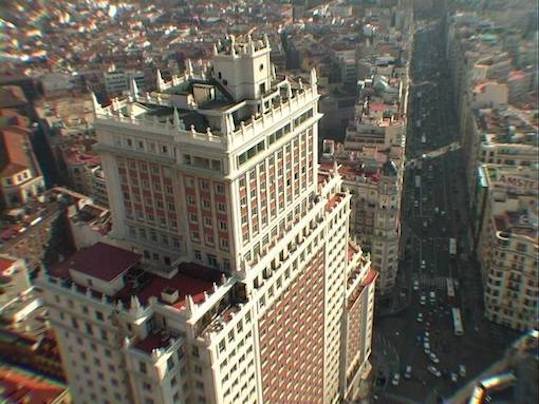
As stated above, the opening credits detail the scale of the structure that we can see before us in the vertiginous opening shot (which I’m guessing was filmed from the Torre de Madrid given the angle), but the filmmaking itself was almost as mammoth a task. Filming over the course of a year – with a coda filmed two years later in 2009 – Moreno collected 200 hours of footage (he explains how the project evolved in this interview), with the style of the film (handheld and observational, without voiceover or score) dictated by what was going on and the need to be able to move around quickly and freely. Although Moreno doesn’t impose a narrative on the film – we see and hear various people working on the building, but there is no voiceover and the protagonist is Edificio España itself – there was arguably a shift in his focus as shooting progressed.
He starts out interested in the empty and abandoned spaces – you can hear the work underway but we don’t initially see many people – but although Moreno remains an unobtrusive presence, as the film progresses he gets closer to people and they get to know each other, before the workers disappear when the renovation stalls. This is mirrored in the order in which we encounter the three security guards and their respective relationships with the building: first is Franco, an exiled Armenian, who seems relatively new to the building at least in so far as he asks questions about what it was like in its heyday; next is Herminio, who has worked there for two years and almost acts as a tour guide to the building and its legends; and finally José, whose life has been touched by the building – he spent his wedding night in the hotel thirty years ago – but he sees this as immaterial (he’s surprised when Moreno asks if he went to look at the room he stayed in before it was gutted – “No. What for?”). It’s the progression of an outsider coming in, becoming immersed in the place, but ultimately only being left with memories and recollections as the physical spaces disappear around them.
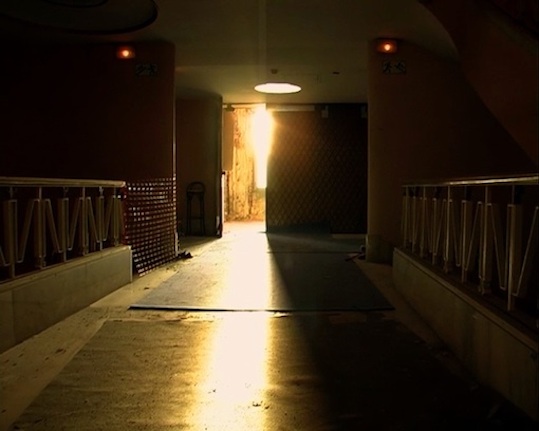
The film starts in a series of abandoned spaces, with captions detailing the floor and zone (apartments, offices) of the building they are located in. ‘Abandoned’ is the best way to describe them because they resemble the aftermath of an apocalyptic event: people appear to have left in a hurry. You might expect to see traces of the lives lived within these walls, but parts of their lives have been left behind: clothes litter the floor, children’s drawings are still stuck on walls, family photographs are scattered around, and kitchenware is stacked on worktops. A sporting trophy – or is it an urn? – is later discovered behind a radiator cover as one of the apartments is stripped, the labourer who discovers it stopping momentarily to read the inscription before balancing it haphazardly on the removed cover and it falls to the floor, another addition to the detritus. In the office spaces, the desks overflow with paperwork, and the stubbed-out ends of two cigarettes sit in an ashtray as if the smoker(s) left mid smoke. The lack of voiceover gives us no context for these images and an air of unreality develops: the building is stuck in a timeless limbo. As workers clear cupboards, lockers, and filing cabinets out of the building, the walls are patterned by absences…a faded patchwork of spaces no longer occupied.
Edificio España resembles a comb: the front façade is the straight edge with the ‘teeth’ tucked behind, a series of light wells that jut out the length of the building and contribute to its labyrinthine nature. Getting lost is a recurring theme – an increasingly irate José, muttering curses under his breath, gets lost going to the canteen (camera in tow), frustratingly finding himself the wrong side of a wall and doorway that are no longer passable – and even the planners are unable to work out where they are on their architectural plans (they have to open a window to orient themselves). Corridors, stairwells, and lifts are interchangeable from the outset – an Escher-like loop of narrow, confined spaces – but the sense of déjà vu increases as the building is gutted and the spaces are anonymised, homogenised, and stripped of what personality they had (although that personality is represented via the objects left behind – including a number of framed photographs of the building and its staff).

It is this stripping and gutting – actions that require effort, and that sound slightly violent – that Moreno is drawn to (‘work’ is a common theme in those of his films I have seen so far, and this one stands as a valorisation of work(ers)), both in terms of the transformation of a defined space (captions usually tell us where we are – although not when people get lost) but also the physical work that that transformation entails. This is manual labour in its truest sense, a physically exhausting itinerary of backbreaking toil done with very little mechanical aid. We see diggers and large pneumatic drills in the underground levels but there’s no way to get them higher up the building; the temperamental lifts (which frequently take people to somewhere other than they have requested) are tiny, only holding a few workers at a time. And so this building is stripped by hand, sledgehammer, and pickaxe. Parquet flooring is dug up, carpets ripped up, and walls knocked down in cramped, dark spaces made even smaller by what is being removed quickly piling up in the vicinity. The sound of the physical thuds of sledgehammers along with the recurring scrape of shovels against concrete as rubble is chucked into wheelbarrows develops into a percussive rhythm as the workers fall into unified motions that are occasionally interrupted by hi-jinx (certain people play to the camera) or a collective winding-up of the overseeing foreman (who implores them to work “con alegría”).

Moreno is a largely unobtrusive presence, sometimes simply observing from the sidelines in the larger spaces (as on the floors that have already been knocked through into one open plan space) or navigating the narrow confines of apartments in the process of being deconstructed – trying to keep out of the way of those who make up a human conveyor belt removing extraneous materials. The various ‘segments’ or strands of the film – the abandoned spaces, the workers, process of transformation, the security guards, the foremen, the planners / real estate people – are interwoven / edited in what seems to be a loosely chronological order. Just as the conversations with security guards mirror Moreno’s progress into Edificio España, his relationship with the labourers also develops over the year. Initially they look indirectly at the camera in sideways glances (perhaps wondering why he isn’t helping them – “The man only films, eh?” asks one Russian [this questioning look (for assistance) reappears in Moreno’s La piedra / The Stone (2013) where he silently observes someone trying to get a massive boulder into the back of their truck]), but as time passes they get used to his presence and openly engage with him (explaining what they’re doing or just continuing their conversations regardless of the camera).
The building becomes a modern Tower of Babel, Spanish labourers working alongside immigrant workers from a multitude of countries. Although Spanish predominates as the lingua franca of the building, not everyone speaks it and not all cultural references are shared (one Spaniard is incredulous that an Ecuadorian and a Russian don’t know of Mickey Mouse or Heidi respectively). The clash of cultures is perhaps most apparent at mealtimes. A crowded and noisy break room incorporates cuisines and conversations of distinct cultural origins: for example, there is a priceless exchange of glances between two Spaniards while they listen to an explanation as to why having two or three wives at the same time is considered advantageous in other cultures.
Aside from two instances where the audio from news broadcasts plays on the soundtrack – the first is a positive economic forecast delivered by then-Prime Minister José Luis Rodríguez Zapatero (on 4th October 2007 if the audio matches the date we see concurrently on the security camera footage), the second is a report indicating that the economic storm has come into view – it is only in the interactions between workers in the in-between times and spaces that the economic crisis that Spain is hurtling towards is hinted at. The planners spinning their spiel about how many units they will fit into the building are almost in a bubble of their own (they reminded me of Mercedes Álvarez’s Mercado de futuros / Futures Market (2011) – real estate fantasies removed from reality), with their plans being adjusted due to planning requirements rather than belt-tightening. In contrast, the cost of living is a recurring theme to the conversations between workers (“We’re going up like prices…Then we’ll go down like salaries” observes one man sardonically to another in a lift) and the imminent bursting of the housing bubble can be found in one man saying that he has to find another apartment because his landlord’s daughter needs to move into his current one as she can’t afford the house she lives in (“Why move to a house if you know you can’t pay for it?” – need vs. want).

The human impact can also be seen in the only long-time occupant of Edificio España encountered by Moreno: Germán, who has held out against leaving the building for as long as possible. In the second half of the film we briefly see a front door with a paper sign taped to the wall saying ‘occupied’, on a floor that is otherwise already gutted (we see the shared internal wall with a spraypainted ‘No’ on it – one of many markers for the demolition workers, but also a sign of resistance in this instance). But it isn’t until near the end of the film that we meet the occupier as he leaves his home of thirty years for the last time. In contrast to the abandoned spaces, Germán’s apartment is light, clean and completely empty, all of his possessions removed. He opens each door in turn for Moreno to capture every room, shyly presenting his home (“Today I have many memories of my wife [who died in 2004] […] because this is like destroying her work”). The camera doesn’t follow him out of the building – he has fretted on the way down in the lift about being untidy without his tie or glasses – but watches him leave through the glass doors of the main foyer. He doesn’t look back.
The camera travels back up in the lift to witness the ‘occupied’ sign being removed and the subsequent destruction of the apartment. A sledgehammer smashes through the ‘No’ from within the last domesticated space in the building. Following the progress of Germán’s front door and the resulting rubble, the camera moves outside of the building for the first time, going to the landfill site to watch the remains of a family home pounded to dust. The film then cuts back to the interior hallway, the space of the front door now bricked up and plastered over, with a close up showing the corners of the ‘occupied’ sign still sellotaped to the wall – more traces of absences, of unoccupied spaces. The camera cuts to the other side of the 180 degree line to show the reverse of that doorway – the internal walls are gone and all that remains is a nondescript concrete space. A caption appears: ’23rd Floor. Germán’s Home’.
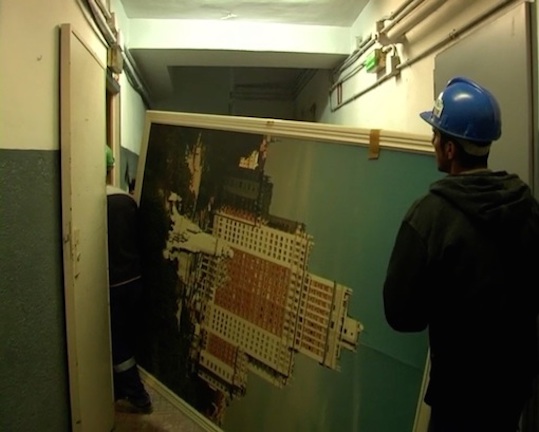
When Moreno briefly returned two years later, very few people were left; many had to return to their home countries due to lack of work, and one of the site managers tells him that most of the Spanish labourers are now on the dole. As he walks around the building, we see that it has been divested of its personality. Everything has been stripped back to rough concrete, a series of identikit spaces that lack the magic over which Herminio enthused when he spoke of the legends and stories that develop around buildings when they endure for a certain amount of time. The renovations came to a complete halt in 2010, the building’s still-impressive façade covering a bare structure within. This highly visible shell of a dictator’s conscious image-making can be read in a number of ways. It remains a Francoist symbol of power, and an unmissable one due to its size and position. Does Moreno capture the demolition of this symbol (predominantly by immigrants), or its endurance (the film ends underground in the building’s foundations – it is still standing, after all)? By extension the structure also represents another side of Franco’s endeavour – as Herminio explains in relation to the artistic friezes in the foyer, “To put it plainly, it’s in praise of capitalism” – and from that perspective the gutted Edificio España symbolises the failure of that system, of the banks, and the property market, on an immense scale that is impossible to ignore or obscure.
Edificio España is available to buy on DVD with optional English subtitles.
This is the last of the pieces that I am reprinting from the old blog. There will be one more piece in the Reprint series (next week), but it’s an article that was first published elsewhere.
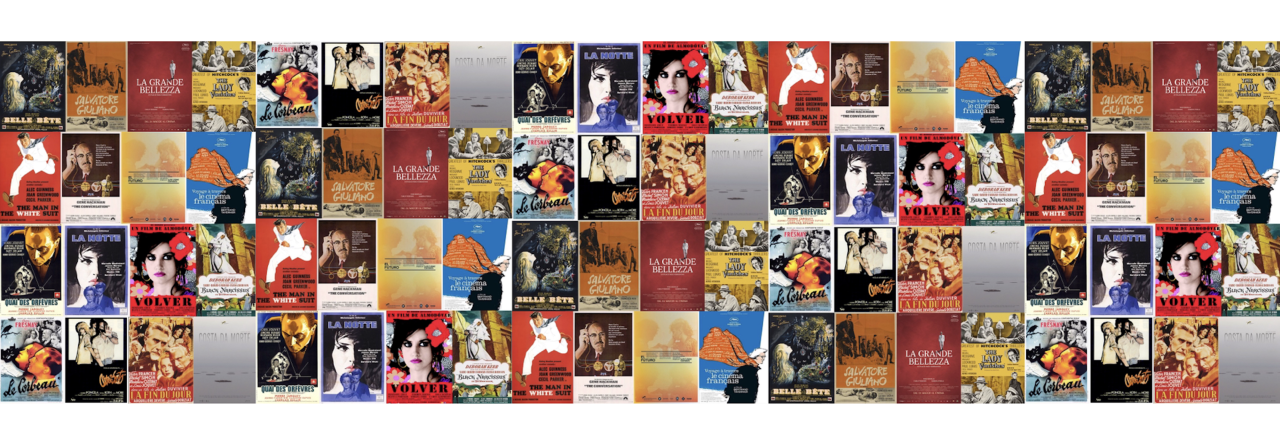
Pingback: 5 Spanish Picks for Edinburgh 2019 – Nobody Knows Anybody
Pingback: 10th Festival Márgenes, online 25th Nov – 13th Dec – Nobody Knows Anybody